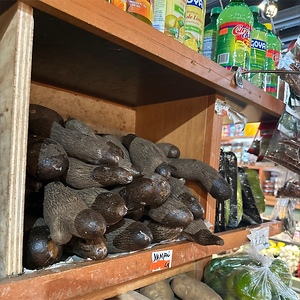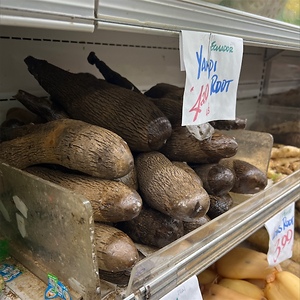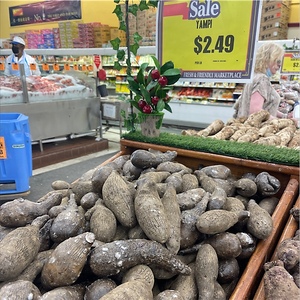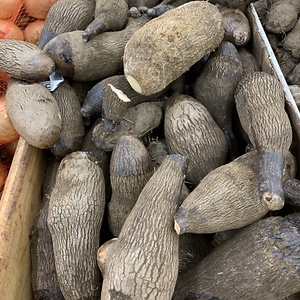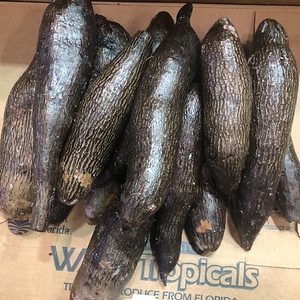

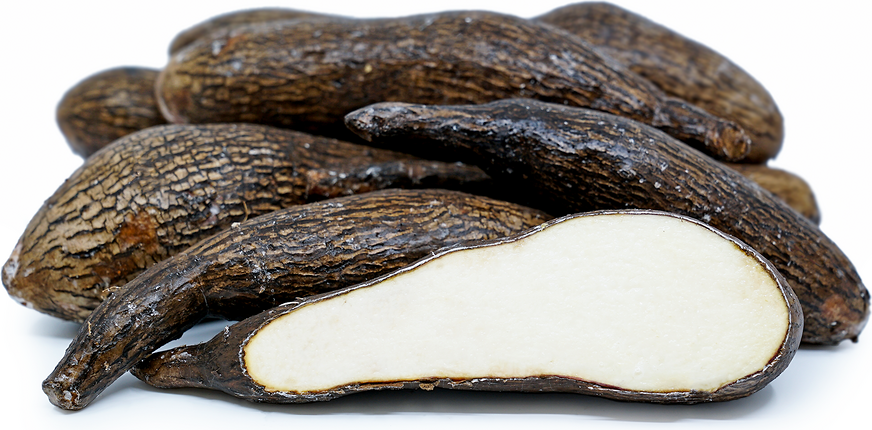
Yampi Root
Estimated Inventory, lb : 0
Description/Taste
Yampi roots are small to medium in size, averaging 15-20 centimeters in length and 6-8 centimeters in diameter, and are elongated, cylindrical, and irregularly-shaped tubers slightly tapering at one end. The skin is thin, smooth, and dark brown with light brown cracks and a variegated appearance. The flesh is firm and moist with a slippery, sometimes slimy texture, and can range in color from white, cream-colored, pink, to purple. When cooked, Yampi root has a tender, soft, and slightly dry texture with a sweet, mild flavor similar to a sweet potato.
Seasons/Availability
Yampi root is available year-round.
Current Facts
Yampi root, botanically classified as Dioscorea trifida, is the tuber of a vining plant with sprawling vines that can reach over three meters in length and is a member of the Dioscoreaceae or yam family. Also known as Indian yam, Tropical yam, Cush-cush in the Caribbean, Yampi or Yampee in Jamaica, Khoai mo in Vietnam, and Mapuey, Inhame, Tabena, and Sacha papa, Yampi roots are known for their sweet flavor and smooth texture when cooked. Yampi root is predominately cultivated in the Caribbean, especially in Jamaica, and South America, and is used as a side dish or as a thickener in soups. Like other yams, Yampi root contains toxic compounds that may irritate the skin and should not be consumed raw.
Nutritional Value
Yampi root is mostly made up of starch and also contains a small amount of protein, vitamin C, iron, phosphorus, calcium, and dietary fiber. It also contains alkaloids which may irritate the skin but disappear upon cooking.
Applications
Yampi root must be cooked as it contains toxic compounds that dissipate when baked, fried, or boiled. It can be cooked and served as a stand-alone side dish or mashed and served in soups. Yampi root is predominately used as a thickener for soups, chowders, stews, and sauces and replaces the need for heavy cream or cornstarch. Yampi root pairs well with coconut milk, onions, garlic, cilantro, bay leaves, turmeric, garam masala, shrimp, and carrots. It can also be used in recipes as a substitute for sweet potatoes. Yampi root should not be refrigerated and will last up to two weeks when stored in a paper bag loosely closed, in a cool, and dry place.
Ethnic/Cultural Info
Yampi roots are a staple food source for many indigenous peoples in the Caribbean and Central America. In Panama, Yampi root grows only sporadically in the wild. There, indigenous populations believe that the plant was sent from heaven in response to the prayers of the people. In the Caribbean, Yampi root is also used as an accompaniment to Christmas ham, which is glazed with pineapple juice, ginger, orange marmalade, and honey, and served with pineapple rings during the holiday season.
Geography/History
Yampi root is native to the Caribbean and Central America and has been used since ancient times. It was first recorded in the 1800s and is the only commercially cultivated yam native to those regions. The cultivation of Yampi root is not widespread as it is a laborious crop to grow and harvest and is mostly grown for home consumption. Today Yampi root can be found at local markets and select specialty grocers in the Caribbean, Central America, South America, Asia, and the United States.
Recipe Ideas
Recipes that include Yampi Root. One
| Run Away Rice |
|
Yampi Root / Yam Soup (Canh Khoai Mo) |
| Wok & Kin |
|
CANH KHOAI MO (CREAMY PURPLE YAM SOUP) |



